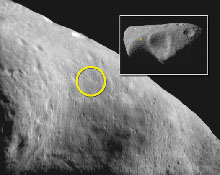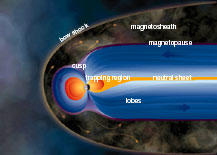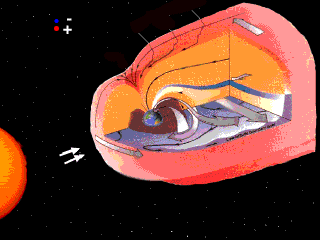This image was taken by IMAGE's EUV imager instrument on August 11, 2000. IMAGE was looking down on the Earth from above the north pole. In this false-color image, you can see a circle in the middle where the Earth is. You can see the Earth's own shadow cast to the bottom left. You can see glowing near the center of the circle - that's the auroral lights. And finally, you can see the tail of the magnetosphere (upper left) being swept back by the solar wind.
Click on image for full size
Courtesy of NASA and the IMAGE science team
IMAGE Shows off its Best Stuff!
News story originally written on February 5, 2001
There has been a lot of exciting news about space missions in the last
week! The
International Space Station is soon to have visitors,
NEAR will land on an asteroid soon and the
IMAGE spacecraft has been showing off its best stuff!
The IMAGE (Imager for Magnetopause -to- Aurora Global Exploration)
spacecraft was launched on March 25, 2000. IMAGE has been
studying the Earth's magnetosphere, the region about the Earth that
contains the Earth's magnetic field. IMAGE is the first spacecraft to
take whole pictures of the Earth's magnetic field. One of those pictures is to the left. This picture shows the Earth's magnetosphere including a
tail-like structure. A magnetotail had been predicted over 30 years ago, and now we have confirmation!
The magnetosphere
of the Earth acts as a shield against the possibly dangerous solar wind
particles that flow from the Sun. But sometimes, explosive events on the Sun can charge the magnetosphere with energy that causes storms. These storms can have
harmless
effects like causing the auroral lights or they can have harmful effects like
damaging satellites or power grids on Earth. So, the IMAGE mission is really important in helping us understand the space weather which affects life on Earth.
You might also be interested in:

The NEAR spacecraft has been in orbit around the asteroid Eros since Valentine's Day of last year. It has met all of its science goals. It has been a huge success! On top of all that, NEAR will attempt
...more
NASA successfully launched the Imager for Magnetopause-to-Aurora Global Exploration (IMAGE) spacecraft on March 25, 2000. It took almost an hour to get the satellite into orbit around the Earth. So far,
...more
The Earth has a magnetic field with north and south poles. The Earth's magnetic field reaches 36,000 miles into space. The magnetic field of the Earth is surrounded in a region called the magnetosphere.
...more
Dangerous particles don't hit the Earth's surface because they are forced by the magnetic field to move around the Earth. Particles do enter at the funnels over the poles or they gain entry far downstream
...more
It was another exciting and frustrating year for the space science program. It seemed that every step forward led to one backwards. Either way, NASA led the way to a great century of discovery. Unfortunately,
...more
The Space Shuttle Discovery lifted off from Kennedy Space Center on October 29th at 2:19 p.m. EST. The weather was great as Discovery took 8 1/2 minutes to reach orbit. This was the United States' 123rd
...more
A moon was discovered orbiting the asteroid, Eugenia. This is only the second time in history that a satellite has been seen circling an asteroid. A special mirror allowed scientists to find the moon
...more















